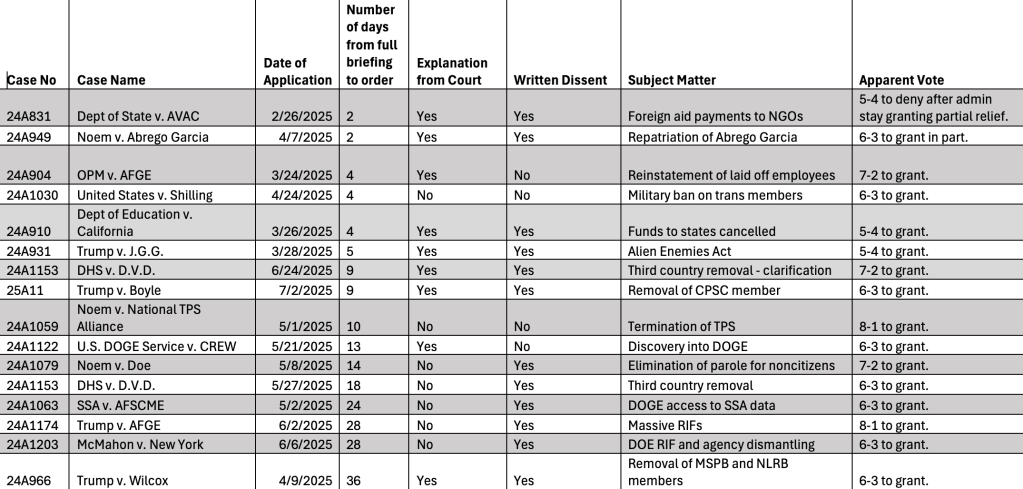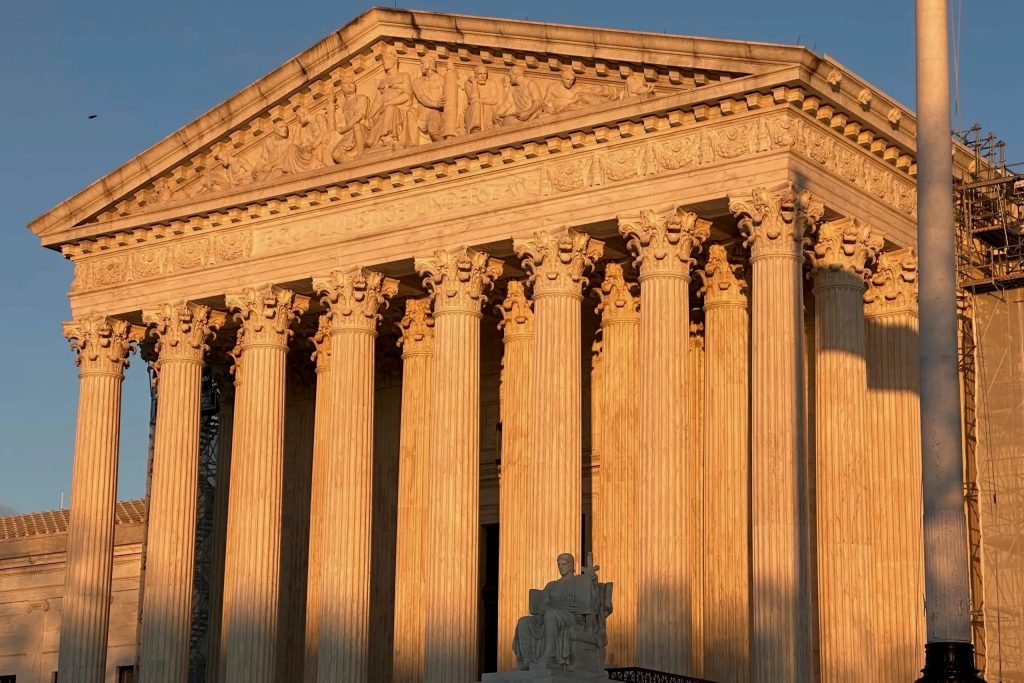Cases and Controversies is a recurring sequence by Carolyn Shapiro, primarily specializing in the results of the Supreme Courtroom’s rulings, opinions, and procedures on the legislation, on different establishments, and on our constitutional democracy extra typically.
Please be aware that the views of out of doors contributors don’t replicate the official opinions of SCOTUSblog or its workers.
Earlier this month, I wrote concerning the court docket’s opinion in Trump v. CASA and why it’s, for my part, very problematic. However a minimum of it was an opinion. In too many different circumstances, the court docket has offered no clarification in any respect for granting emergency functions filed by the Trump administration.
Not too long ago, for instance, in McMahon v. New York, on an obvious 6-3 vote, it stayed an injunction that may have stopped the administration from dismantling the Division of Training, a congressionally created company. And in Trump v. American Federation of Government Employees, on an obvious 8-1 vote, the court docket stayed an injunction that may have stopped the federal government from planning for a large sequence of reductions in power in quite a few companies. The bulk gave no causes for these stays. That’s been true in about half of the circumstances through which the court docket has stayed decrease court docket injunctions and orders on an emergency foundation on the request of the Trump administration.
Many commentators have criticized the court’s failure to elucidate its rulings in these and different circumstances, as have the dissenting justices. The court docket’s silence leaves district courts and litigants with no steering about what explicit features of the stayed injunctions have been problematic. In some circumstances, the district courts issued pages and pages of factual findings, however we (and so they) don’t have any method of realizing if the court docket considers a few of them prone to be clearly inaccurate or in a roundabout way irrelevant. In some circumstances, the decrease courts included important authorized evaluation, however we (and so they) don’t know with what, if something, the court docket disagrees. In Department of Homeland Security v D.V.D., through which the federal government is sending noncitizens to nations they don’t have any connection to and that could be harmful for them, the Supreme Courtroom even seems to be rewarding the government’s gamesmanship in its appeals, however with out a proof, we are able to’t know if the bulk took the administration’s conduct under consideration.
If a district court docket have been to grant a preliminary injunction – the usual for which largely tracks the usual for a keep – with out saying why, reviewing courts, together with the Supreme Courtroom, would probably decide that the district court docket had abused its discretion and, at a minimal, would remand the case for a proof. So why isn’t the bulk holding itself to the identical customary? Why is it so usually silent because it grants emergency reduction to the Trump administration?
Perhaps it’s as a result of the bulk itself doesn’t have a typical rationale for the rulings. In fact, that’s a idea I can’t confirm. However the tempo of the circumstances through which the court docket has offered emergency reduction to the federal government is suggestive. Because the desk under signifies, the court docket has typically taken longer – generally weeks longer – to difficulty its rulings in circumstances the place it supplies no clarification. One may anticipate the alternative – that the court docket can be extra probably to offer a proof when it takes extra time than when it guidelines in a short time. This considerably shocking sample suggests the doable inference that within the circumstances with no causes given, the bulk has struggled unsuccessfully to discover a frequent rationale and has given up.

Be aware: This desk doesn’t embrace (1) Trump v. CASA as a result of the court docket ordered oral argument in that case, treating it very in another way from different emergency functions; (2) Bessent v. Dellinger, which was filed on Feb. 16 and absolutely briefed by Feb. 19, as a result of the court docket held it in abeyance after which dismissed it as moot based mostly on developments within the decrease courts, and (3) National Institutes of Health v. American Public Health Association, filed on July 24, as a result of it’s neither absolutely briefed nor determined.
Within the early rounds of emergency functions that the Trump administration dropped at the Supreme Courtroom, the court docket acted in a short time. The desk lists seven emergency functions that the federal government filed earlier than Could. In six of these seven circumstances, the court docket issued an order between one and 5 days after the matter was absolutely briefed, granting a minimum of a few of the reduction the federal government sought. (In a single case, Trump v. Wilcox, through which the decrease courts enjoined the president’s elimination of members of the Advantage Techniques Safety Board and the Nationwide Labor Relations Board, the court docket took 36 days to rule – the longest of any emergency software. However in that case, the chief justice issued an administrative stay nearly instantly, conserving the injunction from going into impact whereas the court docket thought of the federal government’s software.)
And in all however a type of seven circumstances, together with Wilcox, the court docket majority offered some type of clarification or steering to the district court docket, though it was typically very quick. Within the seventh case, United States v. Shilling, the court docket offered no clarification because it stayed an injunction that may have prevented the navy from discharging its transgender servicemembers on an obvious 6-3 vote.
For the 9 functions filed and dominated on since Could 1, alternatively, the court docket took a minimum of 9 and as many as 28 days to difficulty a ruling, and it gave any motive or steering in any respect in solely three. Certainly, for 2 of the latest functions it granted, Trump v. AFGE and McMahon v. New York, the court docket took 28 days to rule after full briefing and offered no clarification in any way, regardless of strong dissents and, in AFGE, a quick concurrence by Justice Sonia Sotomayor explaining why she joined the bulk.
Definitely, lack of settlement inside the majority is just not the one doable clarification for the sample I’ve recognized. As the tip of June approaches, the justices and their legislation clerks are beneath a whole lot of strain. It’s the busiest time on the court docket, and a spotlight is undoubtedly centered on different issues. However I don’t suppose that point strain actually can clarify the longer waits and fewer clarification. In any case, the orders in Trump v. AFGE and McMahon got here 11 and 17 days, respectively, after the court docket issued its final opinions in deserves circumstances on June 27. There was loads of time for almost all to elucidate itself.
One other doable clarification for the longer timeframes, though not for almost all’s silence, is that each AFGE and McMahon had comparatively prolonged dissents. So maybe the bulk was ready for the dissenters to complete. However the court docket can and does often difficulty orders with the promise of subsequent dissenting opinions or different separate statements by particular person justices to come back. It did simply that in A.A.R.P. v. Trump when it ordered the federal government to not take away from the nation any members of a putative class of noncitizens pursuant to the Alien Enemies Act, over Justices Samuel Alito and Clarence Thomas’ famous however unexplained dissents. (Alito subsequently issued an opinion explaining their views.) And one may suppose that the prolonged dissents in AFGE and McMahon would make the bulk extra, slightly than much less, inclined to elucidate itself. If it might attain consensus on its causes, that’s.
Even when I’m proper concerning the majority’s incapacity to agree on a rationale, nevertheless, the court docket has choices aside from issuing unexplained stays. It might, for instance, ship the case again to the decrease courts directing them to deal with explicit authorized or factual points. It might schedule argument, because it did in Trump v. CASA, and/or name for extra briefing to deal with the justices’ areas of concern.
What it shouldn’t be doing is failing to offer even the views of particular person justices who agree {that a} keep is acceptable. Particular person justices can and may clarify their positions in concurring opinions, together with disclosure of disagreements inside the majority. Certainly, even when Sotomayor concurred with the bulk in Trump v. AFGE, she defined solely why she thought the keep the court docket was issuing was not prone to irreparably hurt the plaintiffs (which isn’t the proper customary for a keep pending enchantment), not why she thought it ought to difficulty in any respect. And in two different circumstances, Noem v. Doe and Noem v. National TPS Alliance, Justice Elena Kagan, and in Doe, Sotomayor, apparently joined the bulk with out clarification.
Finally, a scarcity of settlement about why to grant a keep ought to give the justices pause concerning the motion they’re taking. Maybe the bulk worries {that a} fractured rationale can be extra complicated than none in any respect. But when the general public, the events, and the decrease courts would get no significant steering from fractured opinions issued on the very preliminary phases of a case, that appears to me to be all of the extra motive for the case to proceed with out the Supreme Courtroom’s intervention, permitting information and authorized arguments to develop within the bizarre course. There could after all be circumstances the place, regardless of inner disagreement over causes, a keep is justifiable. However even such a conclusion can and must be defined. That’s what courts are purported to do.
Circumstances: Department of Homeland Security v. D.V.D., Trump v. American Federation of Government Employees, McMahon v. New York, Trump v. CASA, Inc., Trump v. Wilcox
Really helpful Quotation:
Carolyn Shapiro,
When the bulk disagrees on the shadow docket,
SCOTUSblog (Jul. 30, 2025, 12:10 PM),
https://www.scotusblog.com/2025/07/when-the-majority-disagrees-on-the-shadow-docket/
